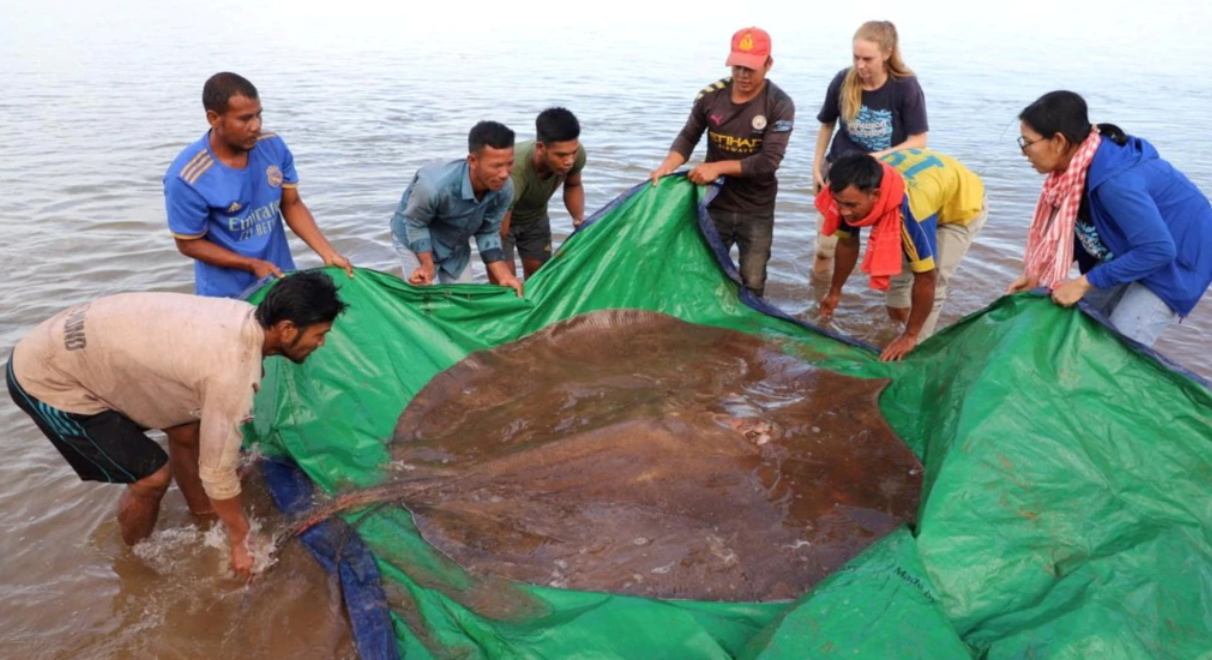
Cambodian fishermen were surprised to discover a rare giant stingray(黄貂鱼) they caught ▲ in the Mekong River. The fishermen caught the endangered fish last week in a deep part of the Mekong in Cambodia’s northeastern Stung Treng province. It measured four meters long and weighed about 180 kilograms.
The giant freshwater stingray is one of Southeast Asia’s largest and rarest species of fish. The stingray was caught when it swallowed a smaller fish that had taken a fisherman’s hook. An international team of experts worked with the fishermen to unhook the fish. The team then examined the stingray before returning it unharmed to the river.
The experts were from Wonders of the Mekong. The group carries out research activities on the Mekong and shares its results with governments and communities along the river. The Mekong River is Southeast Asia’s longest, passing through China, Laos, Thailand, Myanmar, Cambodia and Vietnam. About 60 million people depend on the river for food and survival.
The Mekong is an important environment for numerous species, both large and small. But the leader of Wonders of the Mekong, Zeb Hogan, says the river’s underwater ecosystem is poorly understood. “These are unseen worlds, neglected and out of sight,” Hogan said in a statement.
Hogan said the catch was “significant” because it “confirms the existence of these big fish in this stretch of river.” However, Hogan added that the faraway area is not well studied and is considered “under threat”.
The area could suffer “devastating ecological effects” if proposed hydropower(水力发电) dam projects move forward, the scientific team said in a statement. Other threats include illegal fishing and serious water pollution. Hogan has been studying biodiversity(生物多样性) in the Mekong for more than 20 years. He said the reduction in population of some freshwater fish in the river was very concerning.
本时文内容由奇速英语国际教育研究院原创编写,未经书面授权,禁止复制和任何商业用途,版权所有,侵权必究!(作者投稿及时文阅读定制请联系微信:18980471698)
1.Which of the following can be put in ▲ in Paragraph 1?
A by skill
B with a net
C by mistake
D by accident
解析:选D。D 推理判断题。根据第二段第一、二句可知,这条巨型淡水黄貂鱼是东南亚最大、最稀有的鱼类之一。它是在吞下一条较小的鱼时被捕获的,这条较小的鱼是用渔民的鱼钩钓上来的。由此推断渔民捕获该鱼实属偶然。故选D。
2.What did the experts do after the stingray was caught?
A They carried out research activities.
B They released it in the river soon after.
C They searched for some information online.
D They took photos and gave it an examination.
解析:选B。B 细节理解题。根据第二段的“The team then examined the stingray before returning it unharmed to the river.”可知,研究小组随后检查了黄貂鱼,然后将其毫发无损地送回了河里。故选B。
3.According to Zeb Hogan, we know that the Mekong River _________.
A flows through six countries before reaching the sea
B still keeps lots of underwater secrets to itself
C provides enough food for humans and wildlife
D presents a biodiversity standard to the world
解析:选B。B 推理判断题。根据第四段的“the river’s underwater ecosystem is poorly understood.”和“These are unseen worlds, neglected and out of sight”可知,人们对湄公河的水下生态系统知之甚少,这些是被忽视了的看不见的世界。由此说明湄公河仍然保留着许多水下秘密。故选B。
4.What has nothing to do with the ecological effects on the Mekong River?
A Fishing illegally.
B Discharging waste water.
C The existence of big fish.
D Building hydropower dams.
解析:选C。C 细节理解题。根据最后一段第一、二句可知,如果拟议的水电大坝项目继续推进,该地区可能会遭受“毁灭性的生态影响”,其他威胁包括非法捕鱼和严重的水污染,即建大坝、非法捕鱼和排放污水都会威胁湄公河的生态环境。文中未提及大型鱼类的存在会影响湄公河的生态。故选C。